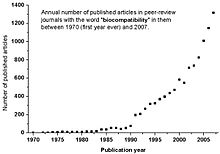
Back توافقية حيوية Arabic Biocompatibilitat Catalan Biokompatibilität German Biocompatibilidad Spanish زیستسازگاری Persian Biocompatibilité French תאימות ביולוגית HE जैवसुसंगति Hindi Biokompatibilitás Hungarian Biocompatibilità Italian
This article needs additional citations for verification. (December 2011) |
Biocompatibility (biomedical therapy): Ability of a material to perform with an appropriate host response in a specific application.[1][a]
Biocompatibility: Ability to be in contact with a living system without producing an adverse effect.[1]

Biocompatibility is related to the behavior of biomaterials in various contexts. The term refers to the ability of a material to perform with an appropriate host response in a specific situation.[2] The ambiguity of the term reflects the ongoing development of insights into how biomaterials interact with the human body and eventually how those interactions determine the clinical success of a medical device (such as pacemaker, hip replacement or stent). Modern medical devices and prostheses are often made of more than one material so it might not always be sufficient to talk about the biocompatibility of a specific material.[3] Even the same materials, such as diamond-like carbon coatings, may show different levels of biocompatibility based on the manufacturing conditions and characteristics.[4]
Since the immune response and repair functions in the body are so complicated it is not adequate to describe the biocompatibility of a single material in relation to a single cell type or tissue. Sometimes one hears of biocompatibility testing that is a large battery of in vitro test[5] that is used in accordance with ISO 10993 (or other similar standards) to determine if a certain material (or rather biomedical product) is biocompatible. These tests do not determine the biocompatibility of a material,[6] but they constitute an important step towards the animal testing and finally clinical trials that will determine the biocompatibility of the material in a given application, and thus medical devices such as implants or drug delivery devices.[7] Research results have concluded that during performing in vitro cytotoxicity testing of biomaterials, "the authors should carefully specify the conditions of the test and comparison of different studies should be carried out with caution".[8]
- ^ a b c Vert, Michel (2012). "Terminology for biorelated polymers and applications (IUPAC Recommendations 2012)" (PDF). Pure and Applied Chemistry. 84 (2): 377–410. doi:10.1351/PAC-REC-10-12-04. S2CID 98107080. Archived from the original (PDF) on 2015-03-19. Retrieved 2013-07-28.
- ^ "Biological Performance of Materials", Jonathan Black,2006, ISBN 0-8493-3959-6
- ^ Considerations for the Biocompatibility Evaluation of Medical Devices, Kammula and Morris, Medical Device & Diagnostic Industry, May 2001
- ^ Zia, Abdul Wasy; Anestopoulos, Ioannis; Panayiotidis, Mihalis I.; Birkett, Martin (10 February 2023). "Soft diamond-like carbon coatings with superior biocompatibility for medical applications". Ceramics International. doi:10.1016/j.ceramint.2023.02.085.
- ^ “In Vitro Biocompatibility Testing of Biomaterials and Medical Devices” Archived 2015-09-24 at the Wayback Machine, U. Muller, Medical Device Technology, March 2008
- ^ "Biocompatibility Safety Assessment of Medical Devices: FDA/ISO and Japanese Guidelines". Mddionline.com. Archived from the original on 29 November 2014. Retrieved 20 November 2014.
- ^ Reshetov, I. V.; Starceva, O. I.; Istranov, A. L.; Vorona, B. N.; Lyundup, A. V.; Gulyaev, I. V.; Melnikov, D. V.; Shtansky, D. V.; Sheveyko, A. N. (2016). "Three-dimensional biocompatible matrix for reconstructive surgery". AIP Conference Proceedings. 1760 (1): 020056. Bibcode:2016AIPC.1760b0056R. doi:10.1063/1.4960275. ISSN 0094-243X.
- ^ Jablonská, Eva; Kubásek, Jiří; Vojtěch, Dalibor; Ruml, Tomáš; Lipov, Jan (2021-03-23). "Test conditions can significantly affect the results of in vitro cytotoxicity testing of degradable metallic biomaterials". Scientific Reports. 11 (1): 6628. Bibcode:2021NatSR..11.6628J. doi:10.1038/s41598-021-85019-6. ISSN 2045-2322. PMC 7987994. PMID 33758226.
Cite error: There are <ref group=lower-alpha> tags or {{efn}} templates on this page, but the references will not show without a {{reflist|group=lower-alpha}} template or {{notelist}} template (see the help page).
© MMXXIII Rich X Search. We shall prevail. All rights reserved. Rich X Search